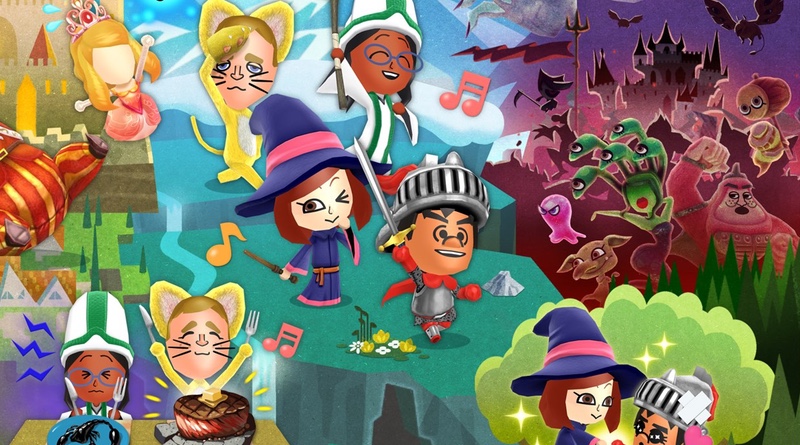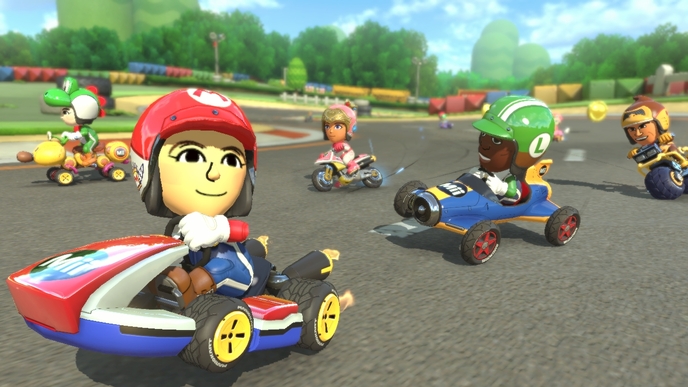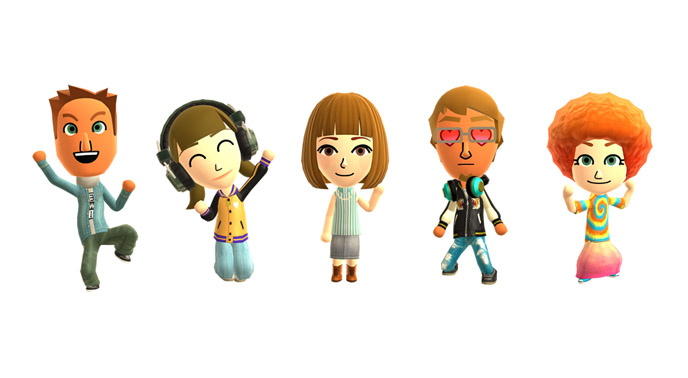
Over a decade after their invention, is the end nigh for Nintendo’s iconic cartoon avatars? Miitopia comes out today, and though it purports to be a whimsical RPG starring you and your friends, it feels more like a portable Valhalla with a MSRP of $39.99. The 3DS is over seven years old, but with one last hardware refresh in the books (the Nintendo 2DSXL, out now), it will continue to be a prominent part of the company’s plans. The lovable Mii, however, once a visible reminder of Nintendo’s then-new raison d’etre — to have us inside their games, swinging and pointing and waving— has been all but forgotten. After over 100 million of them were born since 2006, it’s time to write their collective eulogy.
The Mii was once not only our in-game avatars but a symbol of Nintendo’s philosophy circa 2006. They were not interested in hyper-realism. The Wii was a standard definition machine when both console competitors had super-charged their graphics chips to output in High Def. The Mii was a flippant reply to those who would attack their dismissal of bleeding-edge tech: here, play as a smiley face with floating orbs for hands. And we did.
For awhile. The once-mighty Wii and its rhyming mascot did burn up eventually. When Nintendo introduced its HD follow-up, the Wii U, they doubled-down on the Mii concept, making them the veritable lifeblood of the new system. Miis infected everything about the console: they galavanted about on the start-up screen like chipmunks in a forest; the bespoke social network was called “Miiverse,” as if to imply inside this hardware casing was a swirl of miniature celestial bodies; the pack-in title, Nintendo Land, starred not Nintendo characters but Miis dressed as Nintendo characters. They were wearing Samus’s helmet. They had stolen Mario’s cap. This time they’d overstepped their bounds. We should have known there’d be consequences.
The narrative conceit of Miitopia, such as it were, is that the Dark Lord is stealing peoples’ faces and you need to help get them back. Yes, actual faces get plucked from now-blank spherical heads, float away, and become attached to various monsters. It’s both a clever way of off-loading creature design to your players (who populate the game with their own Miis) and a suitable coda for the “Mii” as avatar. Ten years ago we delighted in tweaking and stretching eyebrows and lips to form the perfect cartoon version of ourselves (or Alf, or Michael Jackson). Now this game asks you to cut those same faces down;they have served their purpose, and to save them, we must set them free.
The shift in focus has been as subtle as a dollop of Heinz Ketchup. Whereas the Wii U had Miis swarm onto your screen as you powered on, the Switch hides the creator software several menu options deep. And though their first phone app, Miitomo, focused on the broad-strokes doppelganger, it seems to have been more experiment than groundwork, with attention being drawn to their other character-driven apps, Super Mario Run and Fire Emblem Heroes.
The Mii idea took root long before we started thwacking tennis balls in our living rooms. In 2000, a non-game application called Mario Artist: Talent Studio was released for the 64DD, a Japan-only add-on to the Nintendo 64. It allowed you to take a picture of your face and attach it to a simple polygonal model, which would then hypothetically show up in other games. With the system’s limited availability, we never saw the concept proliferate as planned. Six years later, the same designer, Yamashita Takayuki, worked on and helped launch the Mii creation software. And eleven years later, with the 3DS’s ability to turn a photo into a Mii face, we finally saw Talent Studio’s idea come to widespread fruition.
Its genius was its simplicity. Other games featured character creation but were often tied to some fantasy epic; the player would be living this character’s life for upwards of hundreds of hours, and so they painstakingly crafted their fictional face. But you could dash off a Mii in 60 seconds. It was meant to approximate features, not depict them accurately. The games you were playing were everyday occurrences, not kingdom-saving excursions. A legendary hero might require a chiseled jawline. But a quick stop at the bowling alley? A few lines and two dots for the eyes will do just fine.
Scott McCloud, in his famed treatise Understanding Comics, explains why a simpler image may resonate more than a photorealistic one. “When we abstract an image through cartooning, we’re not so much eliminating details as we are focusing on specific details,” he writes. “By stripping down an image to is essential ‘meaning,’ an artist can amplify that meaning in a way that realistic art can’t.”
When we made a Mii, we had no choice but to amplify our features. Whatever we chose—big eyes, grinning mouth, spiky hair—became an easily readable version of our in-game persona. We weren’t artists creating a character so much as players crafting a quick stand-in, a kind of stunt double for our digital interactions.
What began as a way to lend personality to a basic sports collection soon amplified its reach. Soon Miis helped millions track their weight and exercise. Soon Miis jammed on public domain tracks while floating in space. The “Wii_____” series of games pushed Nintendo’s hail mary low-tech console into millions of homes. But the Miis were not done.
They were now in your system. They started appearing elsewhere. They’d be in the crowd of other games, their flat countenances cheering you on. They’d show up as secret characters in Mario Kart. You could choose to dismiss Mario himself and run and jump on Goombas as yourself in New Super Mario Bros. U, the Nintendo equivalent of a snake-eating-its-own-tail paradox.
Then things got weird. In Animal Crossing: New Leaf, the peaceful game of paying off your mortgage and watering plants, you could obtain a mask of your own Mii head. In Tomodachi Life, you didn’t even control your Mii; instead, you picked a collection of them to live in an apartment complex and watch them live out their days. They’d go to the cafe and chat. They’d plunk a coin in a wishing well. They’d have nightmarish fever dreams and wake up, sweating, only to walk over to a neighbor’s and practice yoga. The Miis had acquired sentience. And they were as inefficient with their time as we were.
But at least they were confined to your Wii, Wii U, or 3DS. At least they couldn’t exist beyond Nintendo’s walled garden and escape into the real world.
Then Nintendo announced they were working on a phone app. And it would feature Miis.
Miitomo is as unlikely as a “first Nintendo mobile game” as you could imagine. While investors cried for Mario or Donkey Kong, Nintendo went and delivered to the larger world an intellectual property everyone could relate to: themselves. Even if you’d never picked up an NES control pad or swung a Wii remote, you knew the main character of Miitomo, because it was you. It allowed for an indirect, intimate form of communication: your Mii went out asking questions to your friends, only to return and repeat their answers. Whatever you typed, the Mii would speak aloud. And for those into cartoon couture, you could finally dress your Mii, long-suffering in his or her monochromatic t-shirt, with a bevy of outrageous duds.
While the app has a certain charm, it always felt more geared toward a shy Japanese marketplace, thirsty for ice-breakers, than the western world and our penchant for braggadocio. Miitomo has been downloaded over 10 million times, but its impact has been far more subdued than when they starred in the worldwide Wii phenomenon. And with Nintendo nearly stripping all mention of Miis from their newest world-conqueror, the Switch, time appears to be running out on our little pronouns made flesh.
With Miitopia, Nintendo is providing the dapper hooligans with one last party. For what is a utopia but a fictional paradise, some longed for respite from the cruelties of real life? Let’s face it: Miis had a good run. They hung around. Stuck it out. We had some great times, me and Mii. Us and them. Wii and I. They deserve a final resting place in a feedback loop of their creators’ creation. They’ve made us laugh. They’ve hit some cross-court winners. Let them travel off into the autostereoscopic distance and save their world, which for awhile had also been ours. But things have changed. It’s time for us to stay behind and work on salvaging our own.
Since 2003, Jon Irwin has been paid to write about film, techno, ice cream, wine, golf, drag-racing, French children and videogames. His first book, Super Mario Bros. 2, was published last year by Boss Fight Books. Follow along: @WinWinIrwin.



